Dysonica Plc: Cost Management, Budgeting, and Performance Evaluation
VerifiedAdded on 2023/06/11
|20
|4441
|362
Case Study
AI Summary
This case study examines Dysonica Plc's financial operations, focusing on cost analysis, budgeting, and performance evaluation. It begins by defining various cost types, including variable, fixed, and semi-variable costs, and explores costing methods like absorption, marginal, and activity-based costing. The study proposes cost-cutting strategies for the company and develops a 12-month budget plan until April 30, 2023. Finally, it evaluates Dysonica Plc's performance based on forecasts and budgets, considering its competitive landscape and the importance of effective financial management for sustainable success. The analysis emphasizes the need for strategic cost control and revenue optimization to maintain a competitive edge.
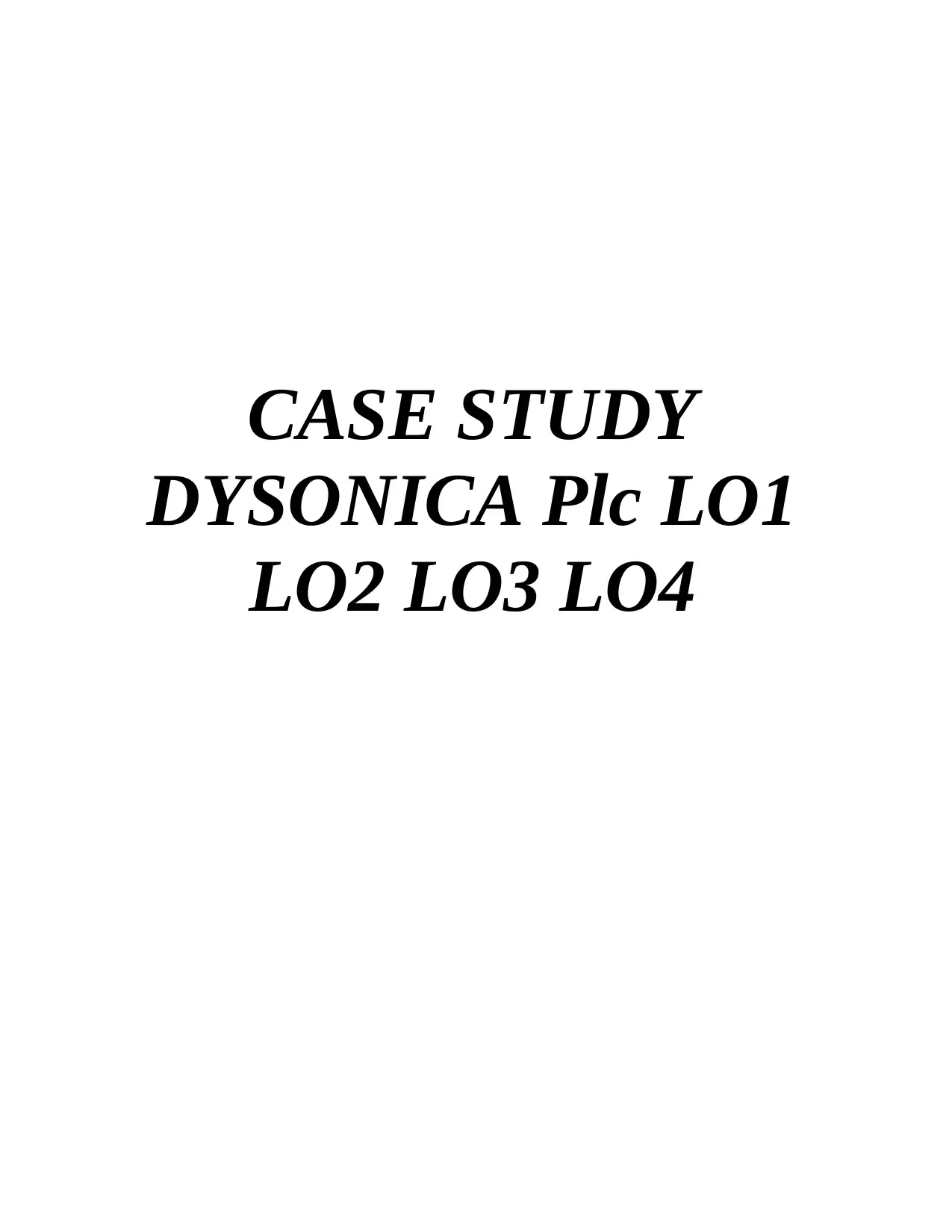
CASE STUDY
DYSONICA Plc LO1
LO2 LO3 LO4
DYSONICA Plc LO1
LO2 LO3 LO4
Paraphrase This Document
Need a fresh take? Get an instant paraphrase of this document with our AI Paraphraser
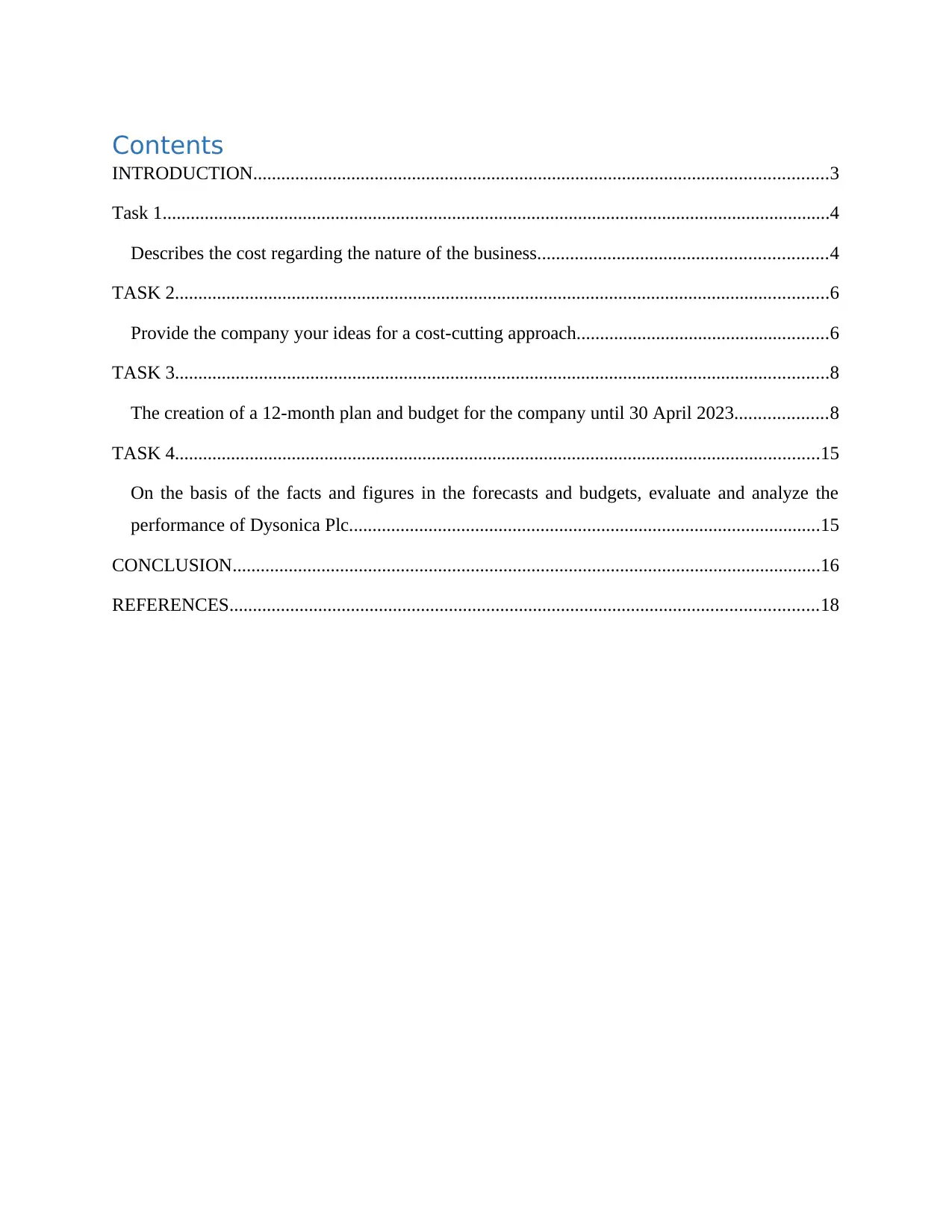
Contents
INTRODUCTION...........................................................................................................................3
Task 1...............................................................................................................................................4
Describes the cost regarding the nature of the business..............................................................4
TASK 2............................................................................................................................................6
Provide the company your ideas for a cost-cutting approach......................................................6
TASK 3............................................................................................................................................8
The creation of a 12-month plan and budget for the company until 30 April 2023....................8
TASK 4..........................................................................................................................................15
On the basis of the facts and figures in the forecasts and budgets, evaluate and analyze the
performance of Dysonica Plc.....................................................................................................15
CONCLUSION..............................................................................................................................16
REFERENCES..............................................................................................................................18
INTRODUCTION...........................................................................................................................3
Task 1...............................................................................................................................................4
Describes the cost regarding the nature of the business..............................................................4
TASK 2............................................................................................................................................6
Provide the company your ideas for a cost-cutting approach......................................................6
TASK 3............................................................................................................................................8
The creation of a 12-month plan and budget for the company until 30 April 2023....................8
TASK 4..........................................................................................................................................15
On the basis of the facts and figures in the forecasts and budgets, evaluate and analyze the
performance of Dysonica Plc.....................................................................................................15
CONCLUSION..............................................................................................................................16
REFERENCES..............................................................................................................................18
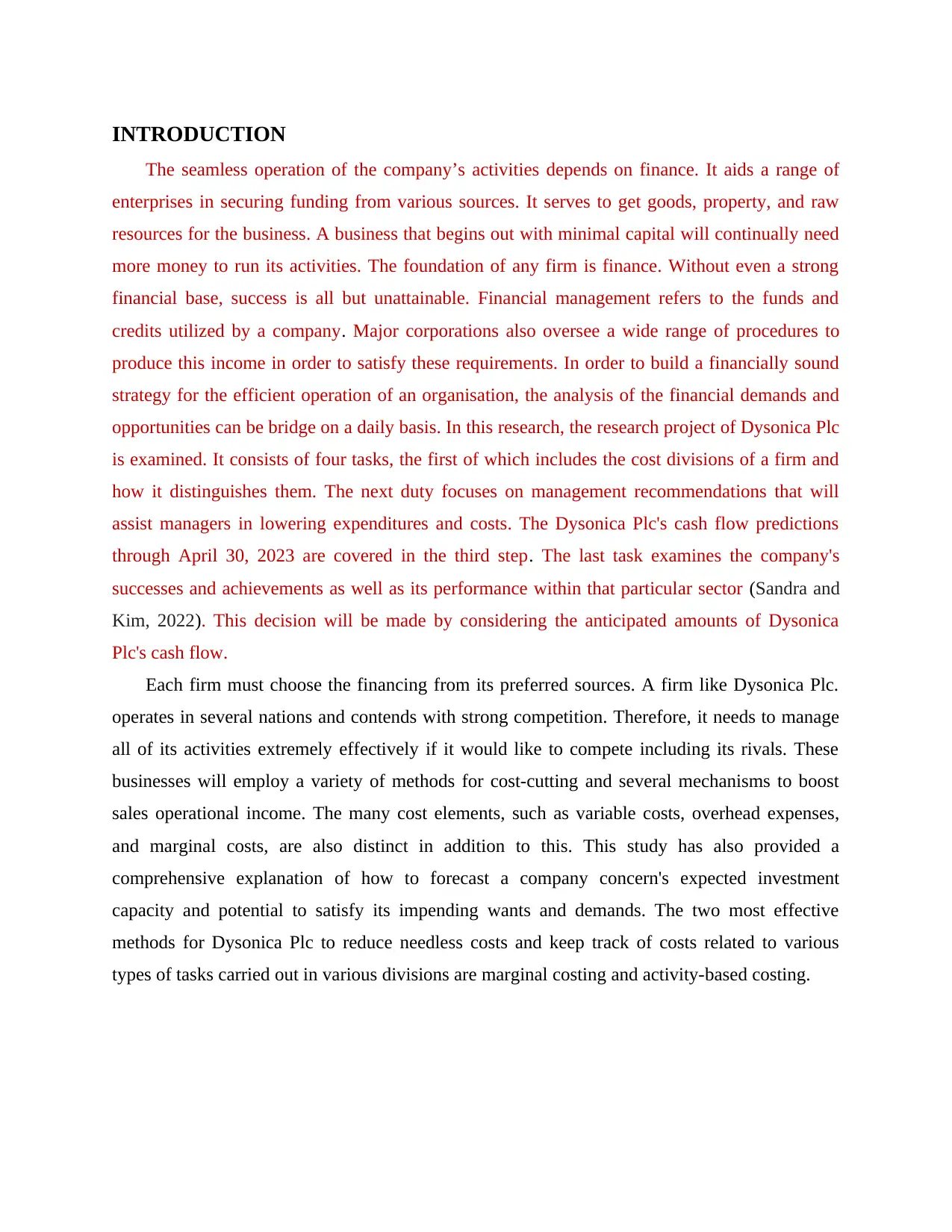
INTRODUCTION
The seamless operation of the company’s activities depends on finance. It aids a range of
enterprises in securing funding from various sources. It serves to get goods, property, and raw
resources for the business. A business that begins out with minimal capital will continually need
more money to run its activities. The foundation of any firm is finance. Without even a strong
financial base, success is all but unattainable. Financial management refers to the funds and
credits utilized by a company. Major corporations also oversee a wide range of procedures to
produce this income in order to satisfy these requirements. In order to build a financially sound
strategy for the efficient operation of an organisation, the analysis of the financial demands and
opportunities can be bridge on a daily basis. In this research, the research project of Dysonica Plc
is examined. It consists of four tasks, the first of which includes the cost divisions of a firm and
how it distinguishes them. The next duty focuses on management recommendations that will
assist managers in lowering expenditures and costs. The Dysonica Plc's cash flow predictions
through April 30, 2023 are covered in the third step. The last task examines the company's
successes and achievements as well as its performance within that particular sector (Sandra and
Kim, 2022). This decision will be made by considering the anticipated amounts of Dysonica
Plc's cash flow.
Each firm must choose the financing from its preferred sources. A firm like Dysonica Plc.
operates in several nations and contends with strong competition. Therefore, it needs to manage
all of its activities extremely effectively if it would like to compete including its rivals. These
businesses will employ a variety of methods for cost-cutting and several mechanisms to boost
sales operational income. The many cost elements, such as variable costs, overhead expenses,
and marginal costs, are also distinct in addition to this. This study has also provided a
comprehensive explanation of how to forecast a company concern's expected investment
capacity and potential to satisfy its impending wants and demands. The two most effective
methods for Dysonica Plc to reduce needless costs and keep track of costs related to various
types of tasks carried out in various divisions are marginal costing and activity-based costing.
The seamless operation of the company’s activities depends on finance. It aids a range of
enterprises in securing funding from various sources. It serves to get goods, property, and raw
resources for the business. A business that begins out with minimal capital will continually need
more money to run its activities. The foundation of any firm is finance. Without even a strong
financial base, success is all but unattainable. Financial management refers to the funds and
credits utilized by a company. Major corporations also oversee a wide range of procedures to
produce this income in order to satisfy these requirements. In order to build a financially sound
strategy for the efficient operation of an organisation, the analysis of the financial demands and
opportunities can be bridge on a daily basis. In this research, the research project of Dysonica Plc
is examined. It consists of four tasks, the first of which includes the cost divisions of a firm and
how it distinguishes them. The next duty focuses on management recommendations that will
assist managers in lowering expenditures and costs. The Dysonica Plc's cash flow predictions
through April 30, 2023 are covered in the third step. The last task examines the company's
successes and achievements as well as its performance within that particular sector (Sandra and
Kim, 2022). This decision will be made by considering the anticipated amounts of Dysonica
Plc's cash flow.
Each firm must choose the financing from its preferred sources. A firm like Dysonica Plc.
operates in several nations and contends with strong competition. Therefore, it needs to manage
all of its activities extremely effectively if it would like to compete including its rivals. These
businesses will employ a variety of methods for cost-cutting and several mechanisms to boost
sales operational income. The many cost elements, such as variable costs, overhead expenses,
and marginal costs, are also distinct in addition to this. This study has also provided a
comprehensive explanation of how to forecast a company concern's expected investment
capacity and potential to satisfy its impending wants and demands. The two most effective
methods for Dysonica Plc to reduce needless costs and keep track of costs related to various
types of tasks carried out in various divisions are marginal costing and activity-based costing.
⊘ This is a preview!⊘
Do you want full access?
Subscribe today to unlock all pages.

Trusted by 1+ million students worldwide
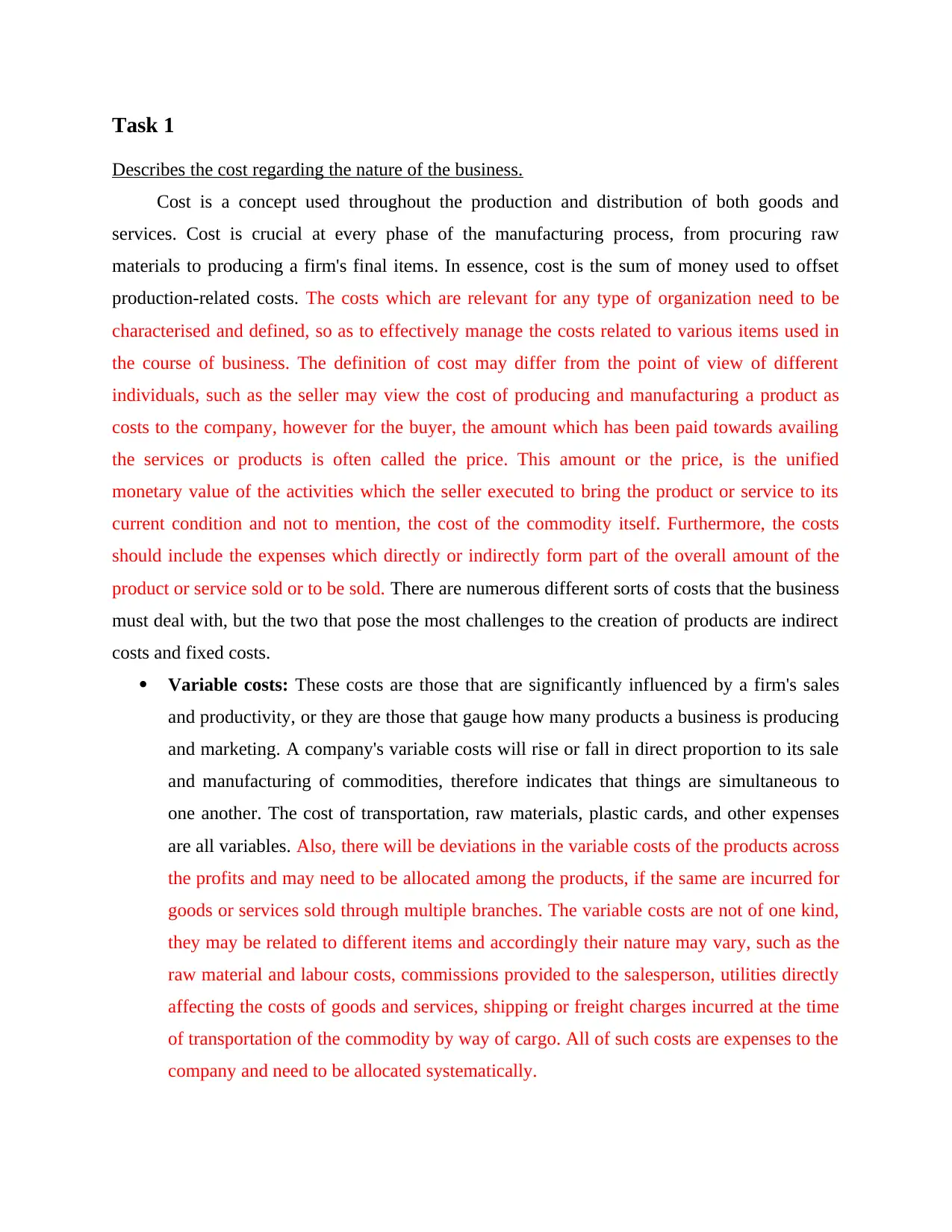
Task 1
Describes the cost regarding the nature of the business.
Cost is a concept used throughout the production and distribution of both goods and
services. Cost is crucial at every phase of the manufacturing process, from procuring raw
materials to producing a firm's final items. In essence, cost is the sum of money used to offset
production-related costs. The costs which are relevant for any type of organization need to be
characterised and defined, so as to effectively manage the costs related to various items used in
the course of business. The definition of cost may differ from the point of view of different
individuals, such as the seller may view the cost of producing and manufacturing a product as
costs to the company, however for the buyer, the amount which has been paid towards availing
the services or products is often called the price. This amount or the price, is the unified
monetary value of the activities which the seller executed to bring the product or service to its
current condition and not to mention, the cost of the commodity itself. Furthermore, the costs
should include the expenses which directly or indirectly form part of the overall amount of the
product or service sold or to be sold. There are numerous different sorts of costs that the business
must deal with, but the two that pose the most challenges to the creation of products are indirect
costs and fixed costs.
Variable costs: These costs are those that are significantly influenced by a firm's sales
and productivity, or they are those that gauge how many products a business is producing
and marketing. A company's variable costs will rise or fall in direct proportion to its sale
and manufacturing of commodities, therefore indicates that things are simultaneous to
one another. The cost of transportation, raw materials, plastic cards, and other expenses
are all variables. Also, there will be deviations in the variable costs of the products across
the profits and may need to be allocated among the products, if the same are incurred for
goods or services sold through multiple branches. The variable costs are not of one kind,
they may be related to different items and accordingly their nature may vary, such as the
raw material and labour costs, commissions provided to the salesperson, utilities directly
affecting the costs of goods and services, shipping or freight charges incurred at the time
of transportation of the commodity by way of cargo. All of such costs are expenses to the
company and need to be allocated systematically.
Describes the cost regarding the nature of the business.
Cost is a concept used throughout the production and distribution of both goods and
services. Cost is crucial at every phase of the manufacturing process, from procuring raw
materials to producing a firm's final items. In essence, cost is the sum of money used to offset
production-related costs. The costs which are relevant for any type of organization need to be
characterised and defined, so as to effectively manage the costs related to various items used in
the course of business. The definition of cost may differ from the point of view of different
individuals, such as the seller may view the cost of producing and manufacturing a product as
costs to the company, however for the buyer, the amount which has been paid towards availing
the services or products is often called the price. This amount or the price, is the unified
monetary value of the activities which the seller executed to bring the product or service to its
current condition and not to mention, the cost of the commodity itself. Furthermore, the costs
should include the expenses which directly or indirectly form part of the overall amount of the
product or service sold or to be sold. There are numerous different sorts of costs that the business
must deal with, but the two that pose the most challenges to the creation of products are indirect
costs and fixed costs.
Variable costs: These costs are those that are significantly influenced by a firm's sales
and productivity, or they are those that gauge how many products a business is producing
and marketing. A company's variable costs will rise or fall in direct proportion to its sale
and manufacturing of commodities, therefore indicates that things are simultaneous to
one another. The cost of transportation, raw materials, plastic cards, and other expenses
are all variables. Also, there will be deviations in the variable costs of the products across
the profits and may need to be allocated among the products, if the same are incurred for
goods or services sold through multiple branches. The variable costs are not of one kind,
they may be related to different items and accordingly their nature may vary, such as the
raw material and labour costs, commissions provided to the salesperson, utilities directly
affecting the costs of goods and services, shipping or freight charges incurred at the time
of transportation of the commodity by way of cargo. All of such costs are expenses to the
company and need to be allocated systematically.
Paraphrase This Document
Need a fresh take? Get an instant paraphrase of this document with our AI Paraphraser
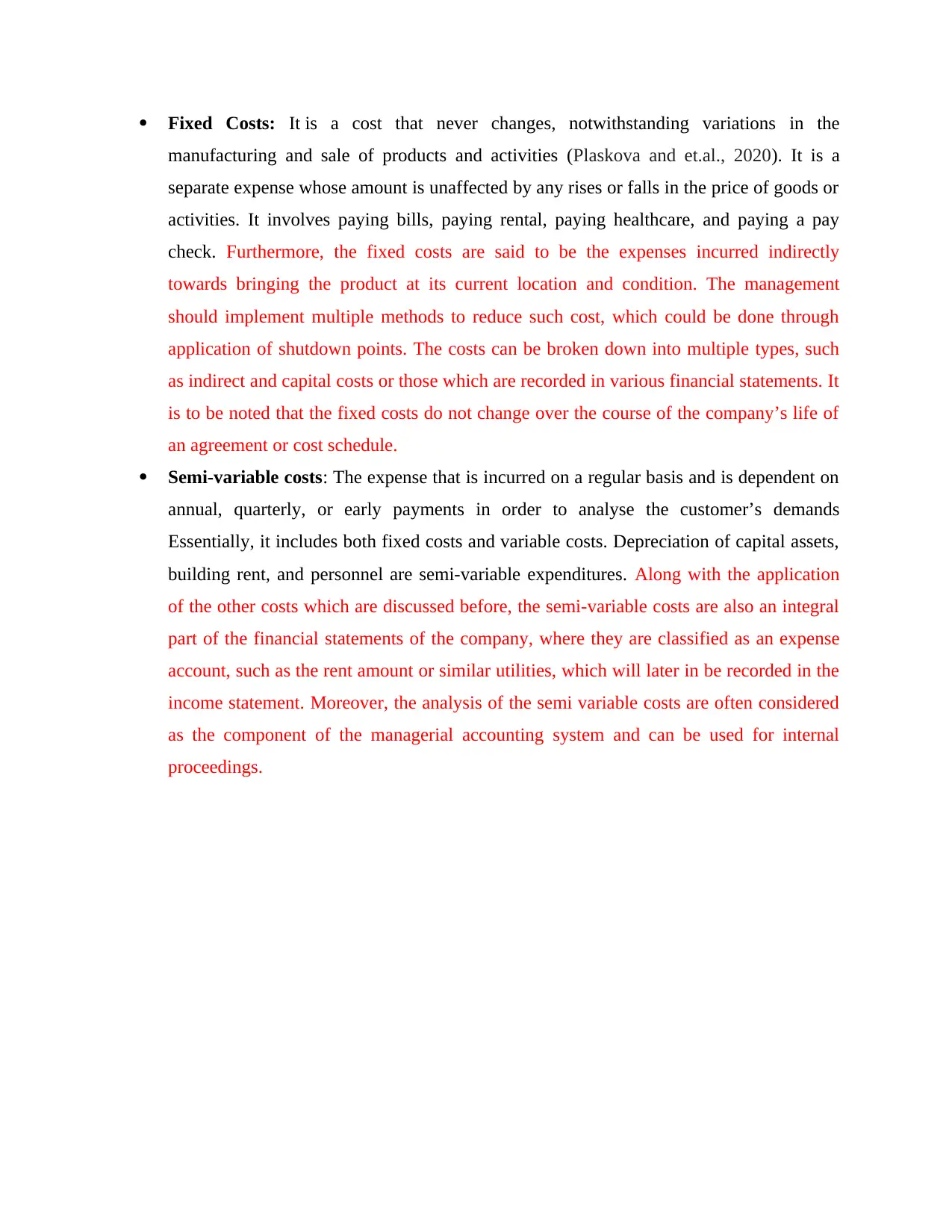
Fixed Costs: It is a cost that never changes, notwithstanding variations in the
manufacturing and sale of products and activities (Plaskova and et.al., 2020). It is a
separate expense whose amount is unaffected by any rises or falls in the price of goods or
activities. It involves paying bills, paying rental, paying healthcare, and paying a pay
check. Furthermore, the fixed costs are said to be the expenses incurred indirectly
towards bringing the product at its current location and condition. The management
should implement multiple methods to reduce such cost, which could be done through
application of shutdown points. The costs can be broken down into multiple types, such
as indirect and capital costs or those which are recorded in various financial statements. It
is to be noted that the fixed costs do not change over the course of the company’s life of
an agreement or cost schedule.
Semi-variable costs: The expense that is incurred on a regular basis and is dependent on
annual, quarterly, or early payments in order to analyse the customer’s demands
Essentially, it includes both fixed costs and variable costs. Depreciation of capital assets,
building rent, and personnel are semi-variable expenditures. Along with the application
of the other costs which are discussed before, the semi-variable costs are also an integral
part of the financial statements of the company, where they are classified as an expense
account, such as the rent amount or similar utilities, which will later in be recorded in the
income statement. Moreover, the analysis of the semi variable costs are often considered
as the component of the managerial accounting system and can be used for internal
proceedings.
manufacturing and sale of products and activities (Plaskova and et.al., 2020). It is a
separate expense whose amount is unaffected by any rises or falls in the price of goods or
activities. It involves paying bills, paying rental, paying healthcare, and paying a pay
check. Furthermore, the fixed costs are said to be the expenses incurred indirectly
towards bringing the product at its current location and condition. The management
should implement multiple methods to reduce such cost, which could be done through
application of shutdown points. The costs can be broken down into multiple types, such
as indirect and capital costs or those which are recorded in various financial statements. It
is to be noted that the fixed costs do not change over the course of the company’s life of
an agreement or cost schedule.
Semi-variable costs: The expense that is incurred on a regular basis and is dependent on
annual, quarterly, or early payments in order to analyse the customer’s demands
Essentially, it includes both fixed costs and variable costs. Depreciation of capital assets,
building rent, and personnel are semi-variable expenditures. Along with the application
of the other costs which are discussed before, the semi-variable costs are also an integral
part of the financial statements of the company, where they are classified as an expense
account, such as the rent amount or similar utilities, which will later in be recorded in the
income statement. Moreover, the analysis of the semi variable costs are often considered
as the component of the managerial accounting system and can be used for internal
proceedings.
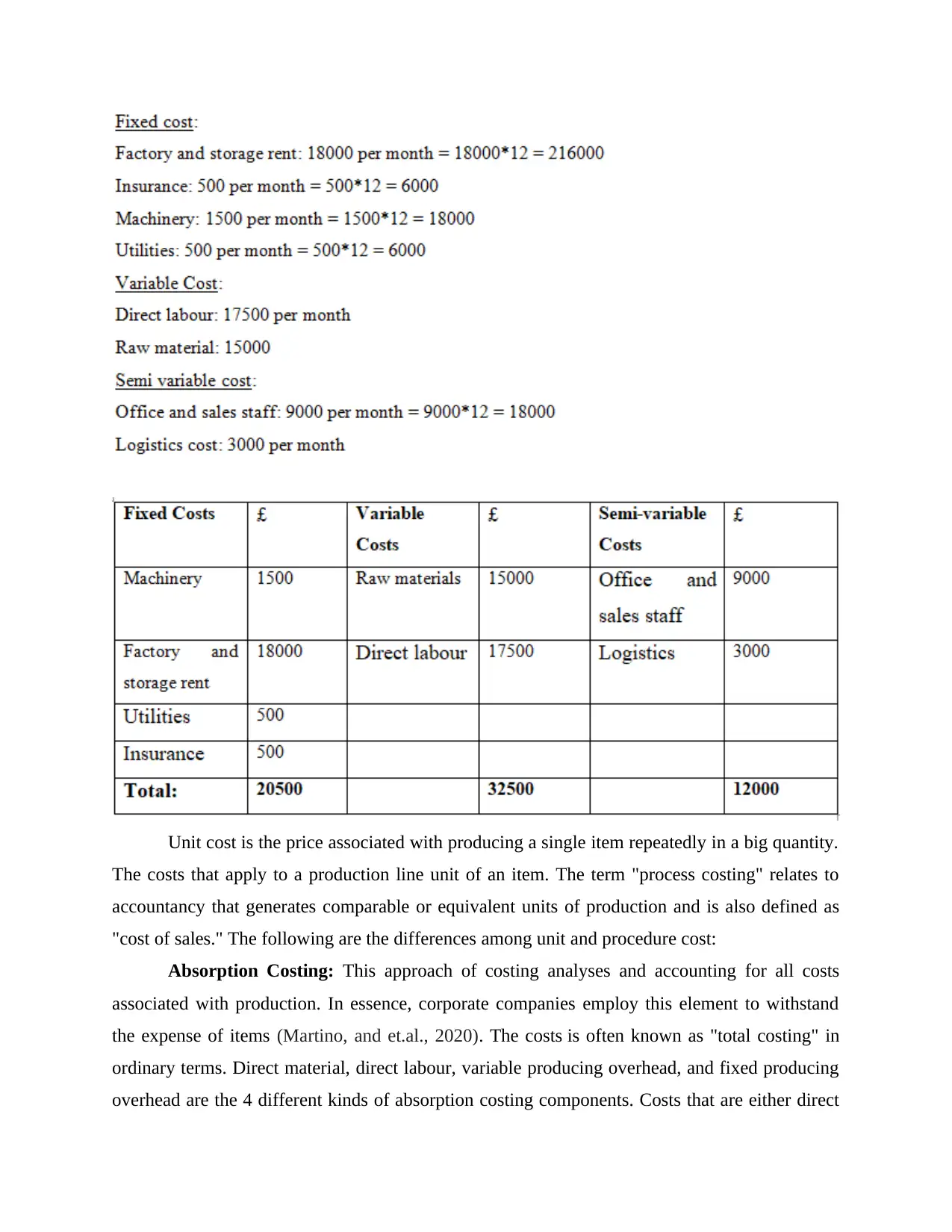
Unit cost is the price associated with producing a single item repeatedly in a big quantity.
The costs that apply to a production line unit of an item. The term "process costing" relates to
accountancy that generates comparable or equivalent units of production and is also defined as
"cost of sales." The following are the differences among unit and procedure cost:
Absorption Costing: This approach of costing analyses and accounting for all costs
associated with production. In essence, corporate companies employ this element to withstand
the expense of items (Martino, and et.al., 2020). The costs is often known as "total costing" in
ordinary terms. Direct material, direct labour, variable producing overhead, and fixed producing
overhead are the 4 different kinds of absorption costing components. Costs that are either direct
The costs that apply to a production line unit of an item. The term "process costing" relates to
accountancy that generates comparable or equivalent units of production and is also defined as
"cost of sales." The following are the differences among unit and procedure cost:
Absorption Costing: This approach of costing analyses and accounting for all costs
associated with production. In essence, corporate companies employ this element to withstand
the expense of items (Martino, and et.al., 2020). The costs is often known as "total costing" in
ordinary terms. Direct material, direct labour, variable producing overhead, and fixed producing
overhead are the 4 different kinds of absorption costing components. Costs that are either direct
⊘ This is a preview!⊘
Do you want full access?
Subscribe today to unlock all pages.

Trusted by 1+ million students worldwide
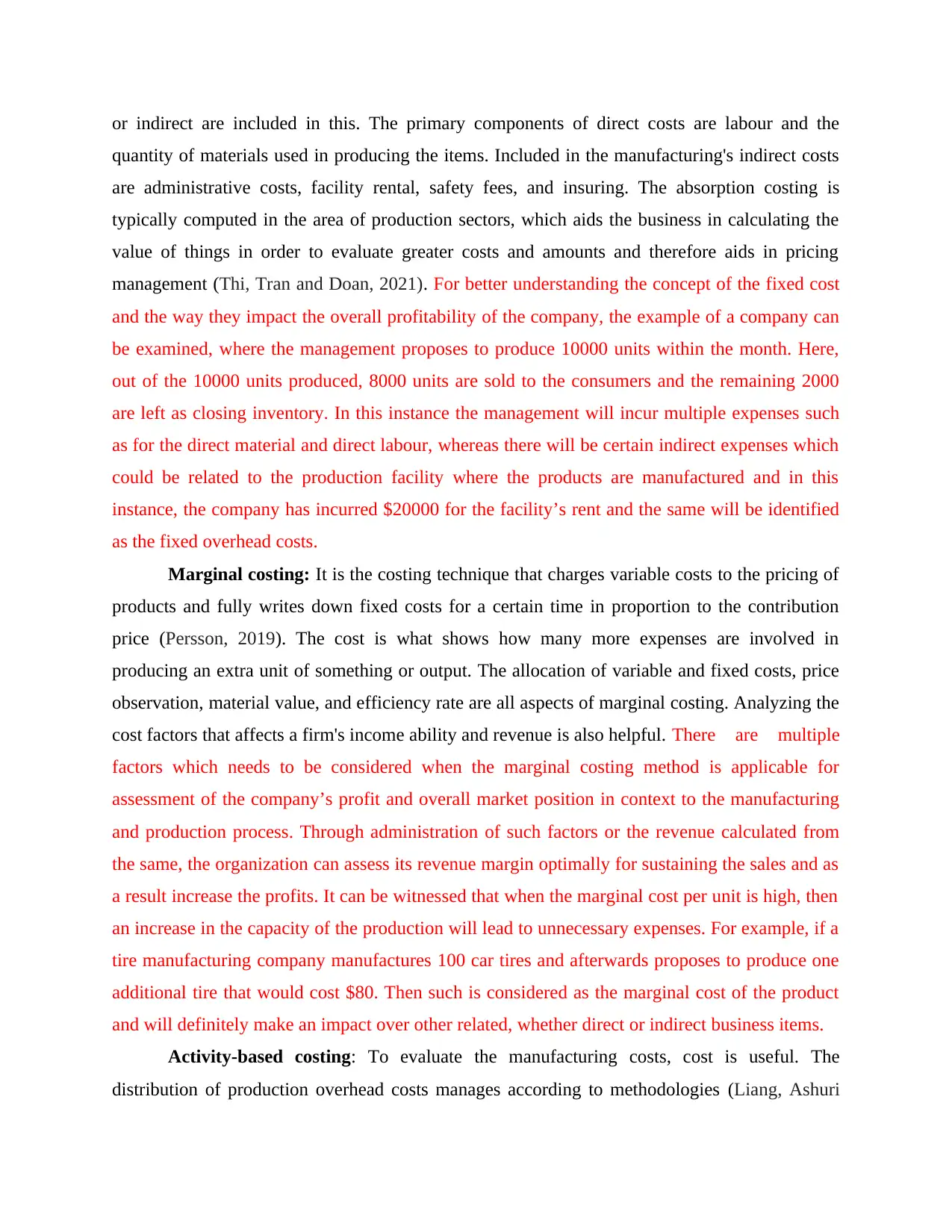
or indirect are included in this. The primary components of direct costs are labour and the
quantity of materials used in producing the items. Included in the manufacturing's indirect costs
are administrative costs, facility rental, safety fees, and insuring. The absorption costing is
typically computed in the area of production sectors, which aids the business in calculating the
value of things in order to evaluate greater costs and amounts and therefore aids in pricing
management (Thi, Tran and Doan, 2021). For better understanding the concept of the fixed cost
and the way they impact the overall profitability of the company, the example of a company can
be examined, where the management proposes to produce 10000 units within the month. Here,
out of the 10000 units produced, 8000 units are sold to the consumers and the remaining 2000
are left as closing inventory. In this instance the management will incur multiple expenses such
as for the direct material and direct labour, whereas there will be certain indirect expenses which
could be related to the production facility where the products are manufactured and in this
instance, the company has incurred $20000 for the facility’s rent and the same will be identified
as the fixed overhead costs.
Marginal costing: It is the costing technique that charges variable costs to the pricing of
products and fully writes down fixed costs for a certain time in proportion to the contribution
price (Persson, 2019). The cost is what shows how many more expenses are involved in
producing an extra unit of something or output. The allocation of variable and fixed costs, price
observation, material value, and efficiency rate are all aspects of marginal costing. Analyzing the
cost factors that affects a firm's income ability and revenue is also helpful. There are multiple
factors which needs to be considered when the marginal costing method is applicable for
assessment of the company’s profit and overall market position in context to the manufacturing
and production process. Through administration of such factors or the revenue calculated from
the same, the organization can assess its revenue margin optimally for sustaining the sales and as
a result increase the profits. It can be witnessed that when the marginal cost per unit is high, then
an increase in the capacity of the production will lead to unnecessary expenses. For example, if a
tire manufacturing company manufactures 100 car tires and afterwards proposes to produce one
additional tire that would cost $80. Then such is considered as the marginal cost of the product
and will definitely make an impact over other related, whether direct or indirect business items.
Activity-based costing: To evaluate the manufacturing costs, cost is useful. The
distribution of production overhead costs manages according to methodologies (Liang, Ashuri
quantity of materials used in producing the items. Included in the manufacturing's indirect costs
are administrative costs, facility rental, safety fees, and insuring. The absorption costing is
typically computed in the area of production sectors, which aids the business in calculating the
value of things in order to evaluate greater costs and amounts and therefore aids in pricing
management (Thi, Tran and Doan, 2021). For better understanding the concept of the fixed cost
and the way they impact the overall profitability of the company, the example of a company can
be examined, where the management proposes to produce 10000 units within the month. Here,
out of the 10000 units produced, 8000 units are sold to the consumers and the remaining 2000
are left as closing inventory. In this instance the management will incur multiple expenses such
as for the direct material and direct labour, whereas there will be certain indirect expenses which
could be related to the production facility where the products are manufactured and in this
instance, the company has incurred $20000 for the facility’s rent and the same will be identified
as the fixed overhead costs.
Marginal costing: It is the costing technique that charges variable costs to the pricing of
products and fully writes down fixed costs for a certain time in proportion to the contribution
price (Persson, 2019). The cost is what shows how many more expenses are involved in
producing an extra unit of something or output. The allocation of variable and fixed costs, price
observation, material value, and efficiency rate are all aspects of marginal costing. Analyzing the
cost factors that affects a firm's income ability and revenue is also helpful. There are multiple
factors which needs to be considered when the marginal costing method is applicable for
assessment of the company’s profit and overall market position in context to the manufacturing
and production process. Through administration of such factors or the revenue calculated from
the same, the organization can assess its revenue margin optimally for sustaining the sales and as
a result increase the profits. It can be witnessed that when the marginal cost per unit is high, then
an increase in the capacity of the production will lead to unnecessary expenses. For example, if a
tire manufacturing company manufactures 100 car tires and afterwards proposes to produce one
additional tire that would cost $80. Then such is considered as the marginal cost of the product
and will definitely make an impact over other related, whether direct or indirect business items.
Activity-based costing: To evaluate the manufacturing costs, cost is useful. The
distribution of production overhead costs manages according to methodologies (Liang, Ashuri
Paraphrase This Document
Need a fresh take? Get an instant paraphrase of this document with our AI Paraphraser
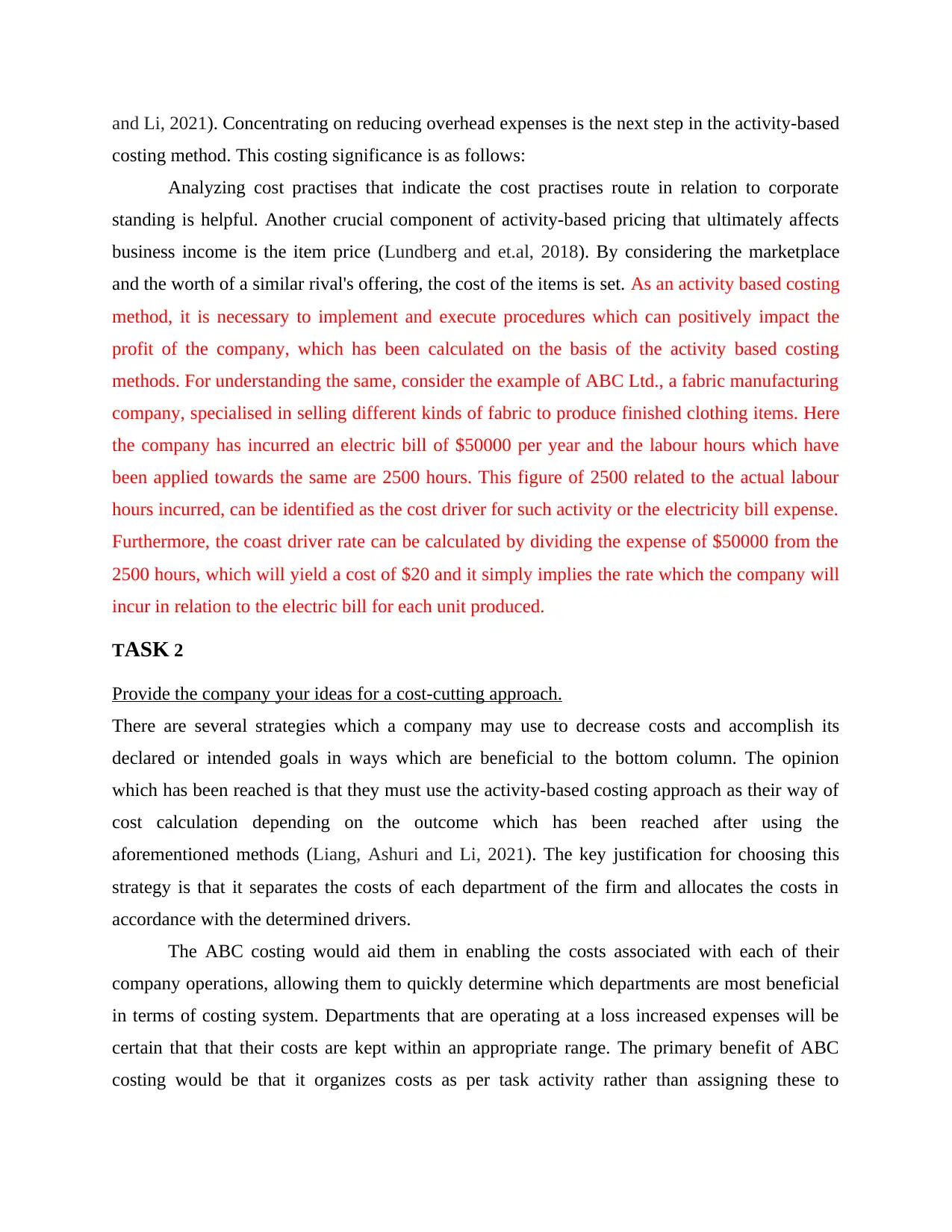
and Li, 2021). Concentrating on reducing overhead expenses is the next step in the activity-based
costing method. This costing significance is as follows:
Analyzing cost practises that indicate the cost practises route in relation to corporate
standing is helpful. Another crucial component of activity-based pricing that ultimately affects
business income is the item price (Lundberg and et.al, 2018). By considering the marketplace
and the worth of a similar rival's offering, the cost of the items is set. As an activity based costing
method, it is necessary to implement and execute procedures which can positively impact the
profit of the company, which has been calculated on the basis of the activity based costing
methods. For understanding the same, consider the example of ABC Ltd., a fabric manufacturing
company, specialised in selling different kinds of fabric to produce finished clothing items. Here
the company has incurred an electric bill of $50000 per year and the labour hours which have
been applied towards the same are 2500 hours. This figure of 2500 related to the actual labour
hours incurred, can be identified as the cost driver for such activity or the electricity bill expense.
Furthermore, the coast driver rate can be calculated by dividing the expense of $50000 from the
2500 hours, which will yield a cost of $20 and it simply implies the rate which the company will
incur in relation to the electric bill for each unit produced.
TASK 2
Provide the company your ideas for a cost-cutting approach.
There are several strategies which a company may use to decrease costs and accomplish its
declared or intended goals in ways which are beneficial to the bottom column. The opinion
which has been reached is that they must use the activity-based costing approach as their way of
cost calculation depending on the outcome which has been reached after using the
aforementioned methods (Liang, Ashuri and Li, 2021). The key justification for choosing this
strategy is that it separates the costs of each department of the firm and allocates the costs in
accordance with the determined drivers.
The ABC costing would aid them in enabling the costs associated with each of their
company operations, allowing them to quickly determine which departments are most beneficial
in terms of costing system. Departments that are operating at a loss increased expenses will be
certain that that their costs are kept within an appropriate range. The primary benefit of ABC
costing would be that it organizes costs as per task activity rather than assigning these to
costing method. This costing significance is as follows:
Analyzing cost practises that indicate the cost practises route in relation to corporate
standing is helpful. Another crucial component of activity-based pricing that ultimately affects
business income is the item price (Lundberg and et.al, 2018). By considering the marketplace
and the worth of a similar rival's offering, the cost of the items is set. As an activity based costing
method, it is necessary to implement and execute procedures which can positively impact the
profit of the company, which has been calculated on the basis of the activity based costing
methods. For understanding the same, consider the example of ABC Ltd., a fabric manufacturing
company, specialised in selling different kinds of fabric to produce finished clothing items. Here
the company has incurred an electric bill of $50000 per year and the labour hours which have
been applied towards the same are 2500 hours. This figure of 2500 related to the actual labour
hours incurred, can be identified as the cost driver for such activity or the electricity bill expense.
Furthermore, the coast driver rate can be calculated by dividing the expense of $50000 from the
2500 hours, which will yield a cost of $20 and it simply implies the rate which the company will
incur in relation to the electric bill for each unit produced.
TASK 2
Provide the company your ideas for a cost-cutting approach.
There are several strategies which a company may use to decrease costs and accomplish its
declared or intended goals in ways which are beneficial to the bottom column. The opinion
which has been reached is that they must use the activity-based costing approach as their way of
cost calculation depending on the outcome which has been reached after using the
aforementioned methods (Liang, Ashuri and Li, 2021). The key justification for choosing this
strategy is that it separates the costs of each department of the firm and allocates the costs in
accordance with the determined drivers.
The ABC costing would aid them in enabling the costs associated with each of their
company operations, allowing them to quickly determine which departments are most beneficial
in terms of costing system. Departments that are operating at a loss increased expenses will be
certain that that their costs are kept within an appropriate range. The primary benefit of ABC
costing would be that it organizes costs as per task activity rather than assigning these to
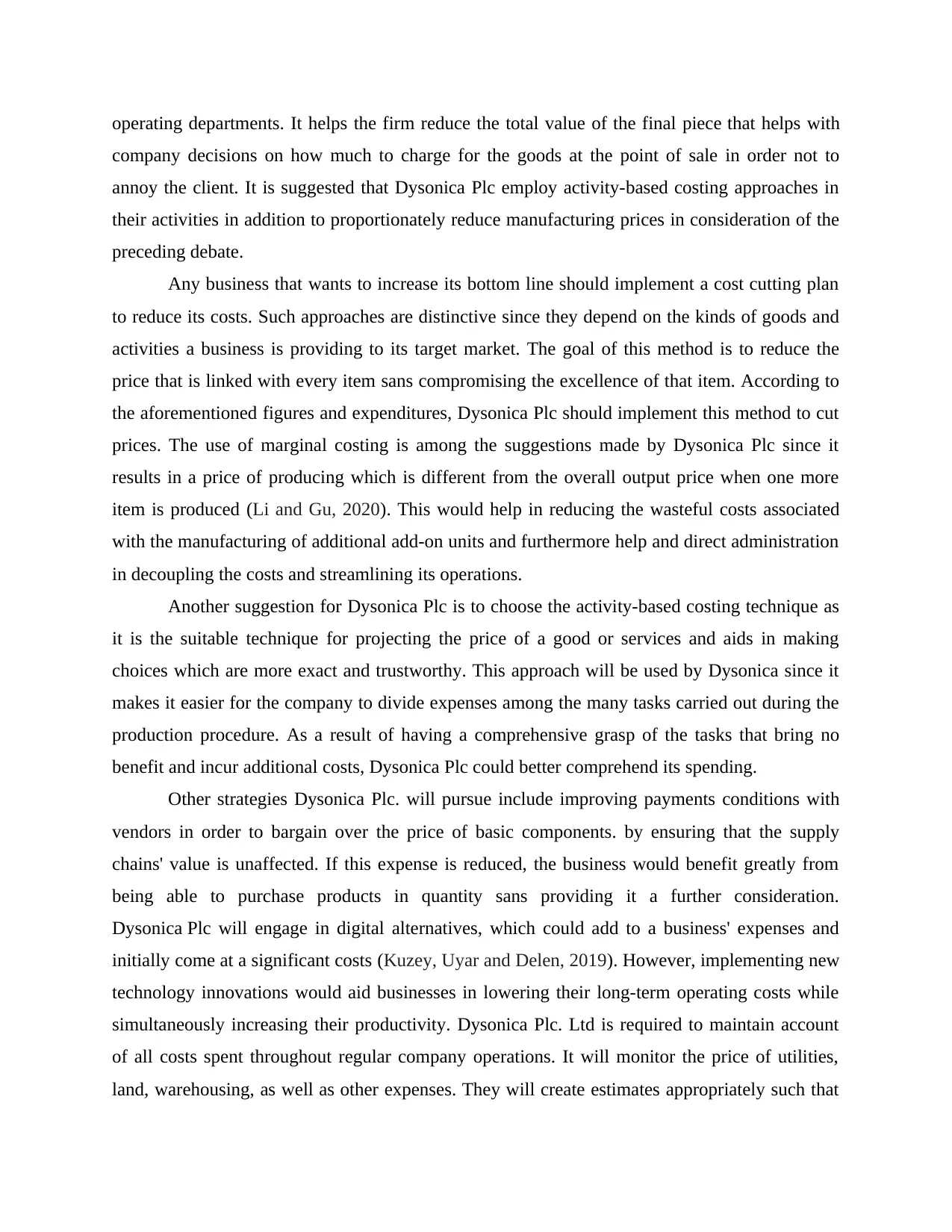
operating departments. It helps the firm reduce the total value of the final piece that helps with
company decisions on how much to charge for the goods at the point of sale in order not to
annoy the client. It is suggested that Dysonica Plc employ activity-based costing approaches in
their activities in addition to proportionately reduce manufacturing prices in consideration of the
preceding debate.
Any business that wants to increase its bottom line should implement a cost cutting plan
to reduce its costs. Such approaches are distinctive since they depend on the kinds of goods and
activities a business is providing to its target market. The goal of this method is to reduce the
price that is linked with every item sans compromising the excellence of that item. According to
the aforementioned figures and expenditures, Dysonica Plc should implement this method to cut
prices. The use of marginal costing is among the suggestions made by Dysonica Plc since it
results in a price of producing which is different from the overall output price when one more
item is produced (Li and Gu, 2020). This would help in reducing the wasteful costs associated
with the manufacturing of additional add-on units and furthermore help and direct administration
in decoupling the costs and streamlining its operations.
Another suggestion for Dysonica Plc is to choose the activity-based costing technique as
it is the suitable technique for projecting the price of a good or services and aids in making
choices which are more exact and trustworthy. This approach will be used by Dysonica since it
makes it easier for the company to divide expenses among the many tasks carried out during the
production procedure. As a result of having a comprehensive grasp of the tasks that bring no
benefit and incur additional costs, Dysonica Plc could better comprehend its spending.
Other strategies Dysonica Plc. will pursue include improving payments conditions with
vendors in order to bargain over the price of basic components. by ensuring that the supply
chains' value is unaffected. If this expense is reduced, the business would benefit greatly from
being able to purchase products in quantity sans providing it a further consideration.
Dysonica Plc will engage in digital alternatives, which could add to a business' expenses and
initially come at a significant costs (Kuzey, Uyar and Delen, 2019). However, implementing new
technology innovations would aid businesses in lowering their long-term operating costs while
simultaneously increasing their productivity. Dysonica Plc. Ltd is required to maintain account
of all costs spent throughout regular company operations. It will monitor the price of utilities,
land, warehousing, as well as other expenses. They will create estimates appropriately such that
company decisions on how much to charge for the goods at the point of sale in order not to
annoy the client. It is suggested that Dysonica Plc employ activity-based costing approaches in
their activities in addition to proportionately reduce manufacturing prices in consideration of the
preceding debate.
Any business that wants to increase its bottom line should implement a cost cutting plan
to reduce its costs. Such approaches are distinctive since they depend on the kinds of goods and
activities a business is providing to its target market. The goal of this method is to reduce the
price that is linked with every item sans compromising the excellence of that item. According to
the aforementioned figures and expenditures, Dysonica Plc should implement this method to cut
prices. The use of marginal costing is among the suggestions made by Dysonica Plc since it
results in a price of producing which is different from the overall output price when one more
item is produced (Li and Gu, 2020). This would help in reducing the wasteful costs associated
with the manufacturing of additional add-on units and furthermore help and direct administration
in decoupling the costs and streamlining its operations.
Another suggestion for Dysonica Plc is to choose the activity-based costing technique as
it is the suitable technique for projecting the price of a good or services and aids in making
choices which are more exact and trustworthy. This approach will be used by Dysonica since it
makes it easier for the company to divide expenses among the many tasks carried out during the
production procedure. As a result of having a comprehensive grasp of the tasks that bring no
benefit and incur additional costs, Dysonica Plc could better comprehend its spending.
Other strategies Dysonica Plc. will pursue include improving payments conditions with
vendors in order to bargain over the price of basic components. by ensuring that the supply
chains' value is unaffected. If this expense is reduced, the business would benefit greatly from
being able to purchase products in quantity sans providing it a further consideration.
Dysonica Plc will engage in digital alternatives, which could add to a business' expenses and
initially come at a significant costs (Kuzey, Uyar and Delen, 2019). However, implementing new
technology innovations would aid businesses in lowering their long-term operating costs while
simultaneously increasing their productivity. Dysonica Plc. Ltd is required to maintain account
of all costs spent throughout regular company operations. It will monitor the price of utilities,
land, warehousing, as well as other expenses. They will create estimates appropriately such that
⊘ This is a preview!⊘
Do you want full access?
Subscribe today to unlock all pages.

Trusted by 1+ million students worldwide
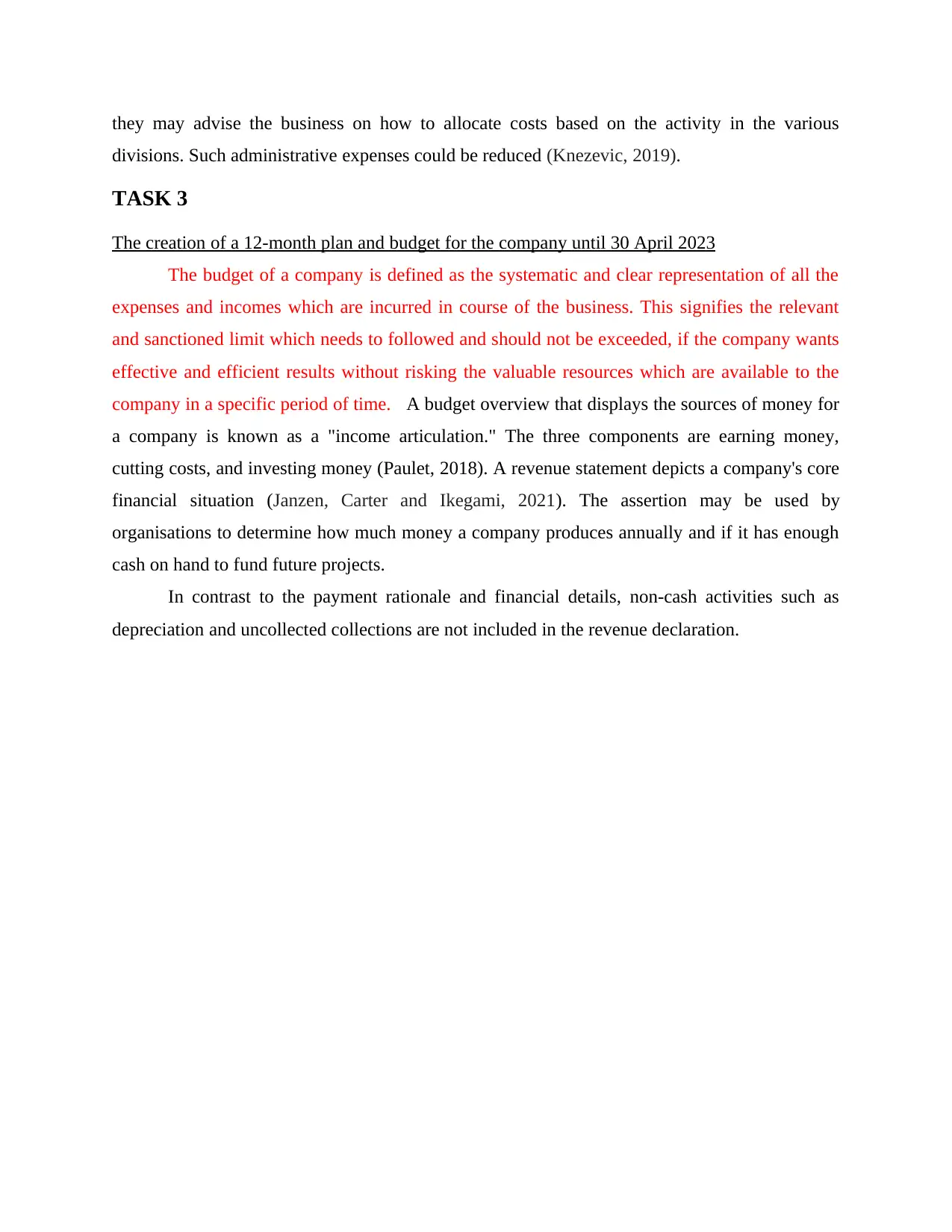
they may advise the business on how to allocate costs based on the activity in the various
divisions. Such administrative expenses could be reduced (Knezevic, 2019).
TASK 3
The creation of a 12-month plan and budget for the company until 30 April 2023
The budget of a company is defined as the systematic and clear representation of all the
expenses and incomes which are incurred in course of the business. This signifies the relevant
and sanctioned limit which needs to followed and should not be exceeded, if the company wants
effective and efficient results without risking the valuable resources which are available to the
company in a specific period of time. A budget overview that displays the sources of money for
a company is known as a "income articulation." The three components are earning money,
cutting costs, and investing money (Paulet, 2018). A revenue statement depicts a company's core
financial situation (Janzen, Carter and Ikegami, 2021). The assertion may be used by
organisations to determine how much money a company produces annually and if it has enough
cash on hand to fund future projects.
In contrast to the payment rationale and financial details, non-cash activities such as
depreciation and uncollected collections are not included in the revenue declaration.
divisions. Such administrative expenses could be reduced (Knezevic, 2019).
TASK 3
The creation of a 12-month plan and budget for the company until 30 April 2023
The budget of a company is defined as the systematic and clear representation of all the
expenses and incomes which are incurred in course of the business. This signifies the relevant
and sanctioned limit which needs to followed and should not be exceeded, if the company wants
effective and efficient results without risking the valuable resources which are available to the
company in a specific period of time. A budget overview that displays the sources of money for
a company is known as a "income articulation." The three components are earning money,
cutting costs, and investing money (Paulet, 2018). A revenue statement depicts a company's core
financial situation (Janzen, Carter and Ikegami, 2021). The assertion may be used by
organisations to determine how much money a company produces annually and if it has enough
cash on hand to fund future projects.
In contrast to the payment rationale and financial details, non-cash activities such as
depreciation and uncollected collections are not included in the revenue declaration.
Paraphrase This Document
Need a fresh take? Get an instant paraphrase of this document with our AI Paraphraser
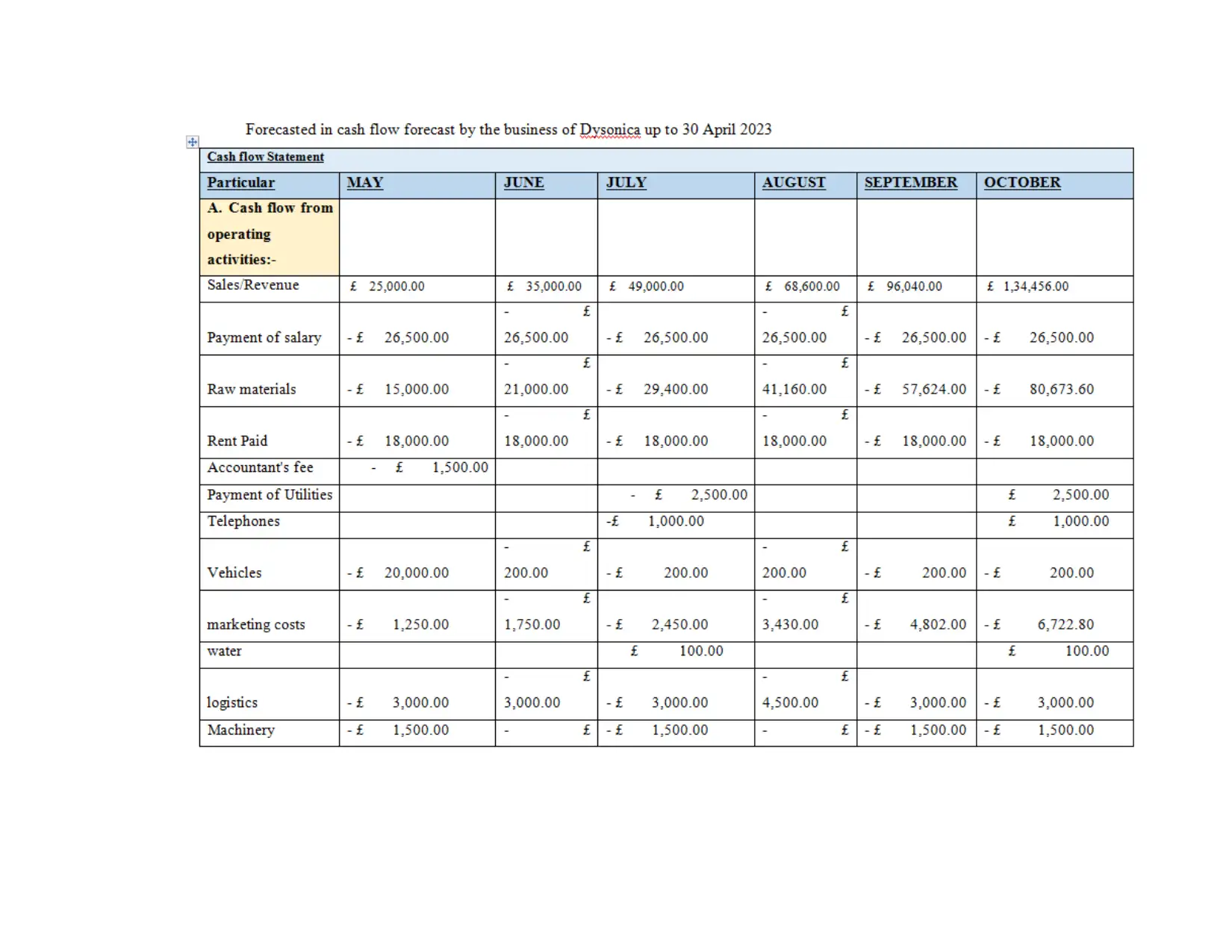
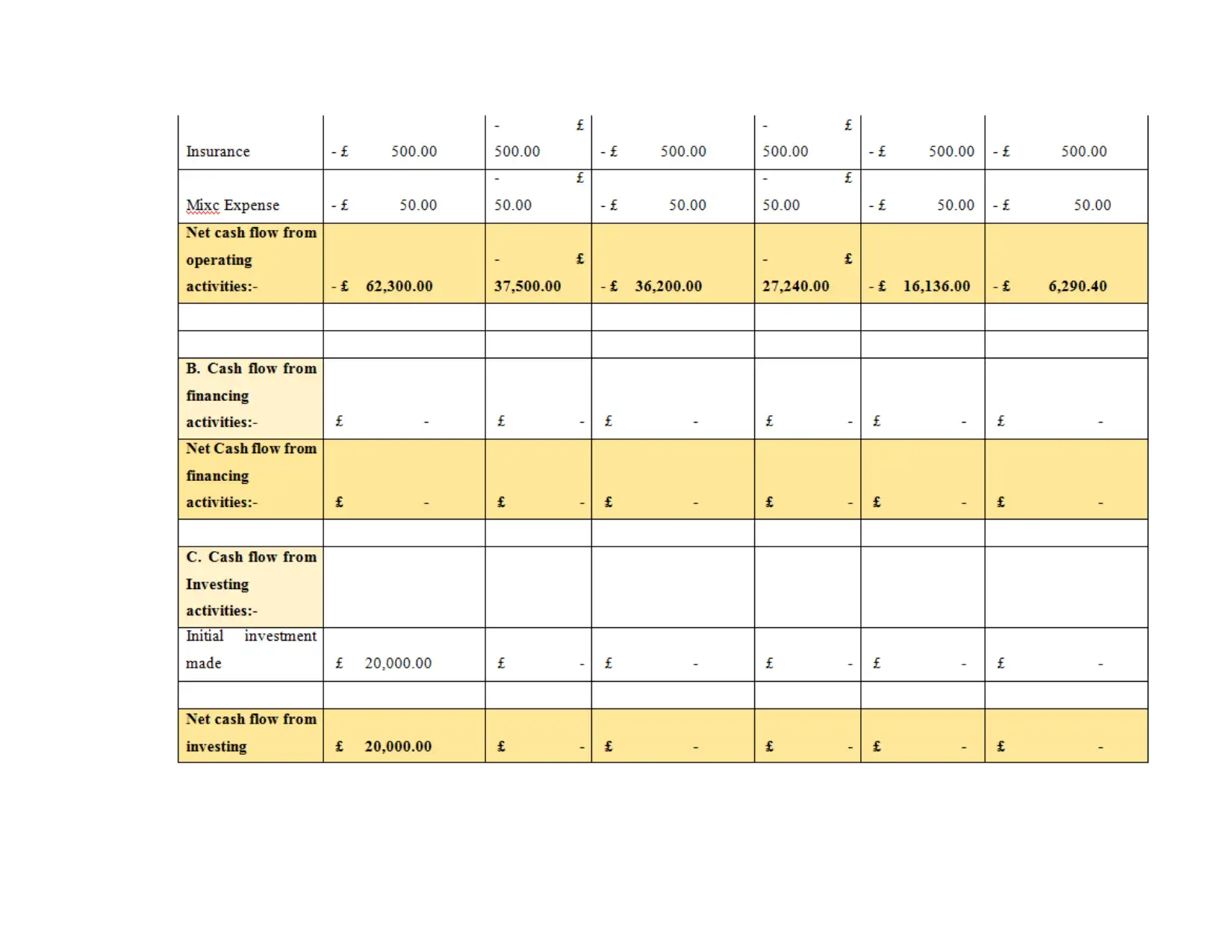
⊘ This is a preview!⊘
Do you want full access?
Subscribe today to unlock all pages.

Trusted by 1+ million students worldwide
1 out of 20
Related Documents
Your All-in-One AI-Powered Toolkit for Academic Success.
+13062052269
info@desklib.com
Available 24*7 on WhatsApp / Email
![[object Object]](/_next/static/media/star-bottom.7253800d.svg)
Unlock your academic potential
Copyright © 2020–2025 A2Z Services. All Rights Reserved. Developed and managed by ZUCOL.





